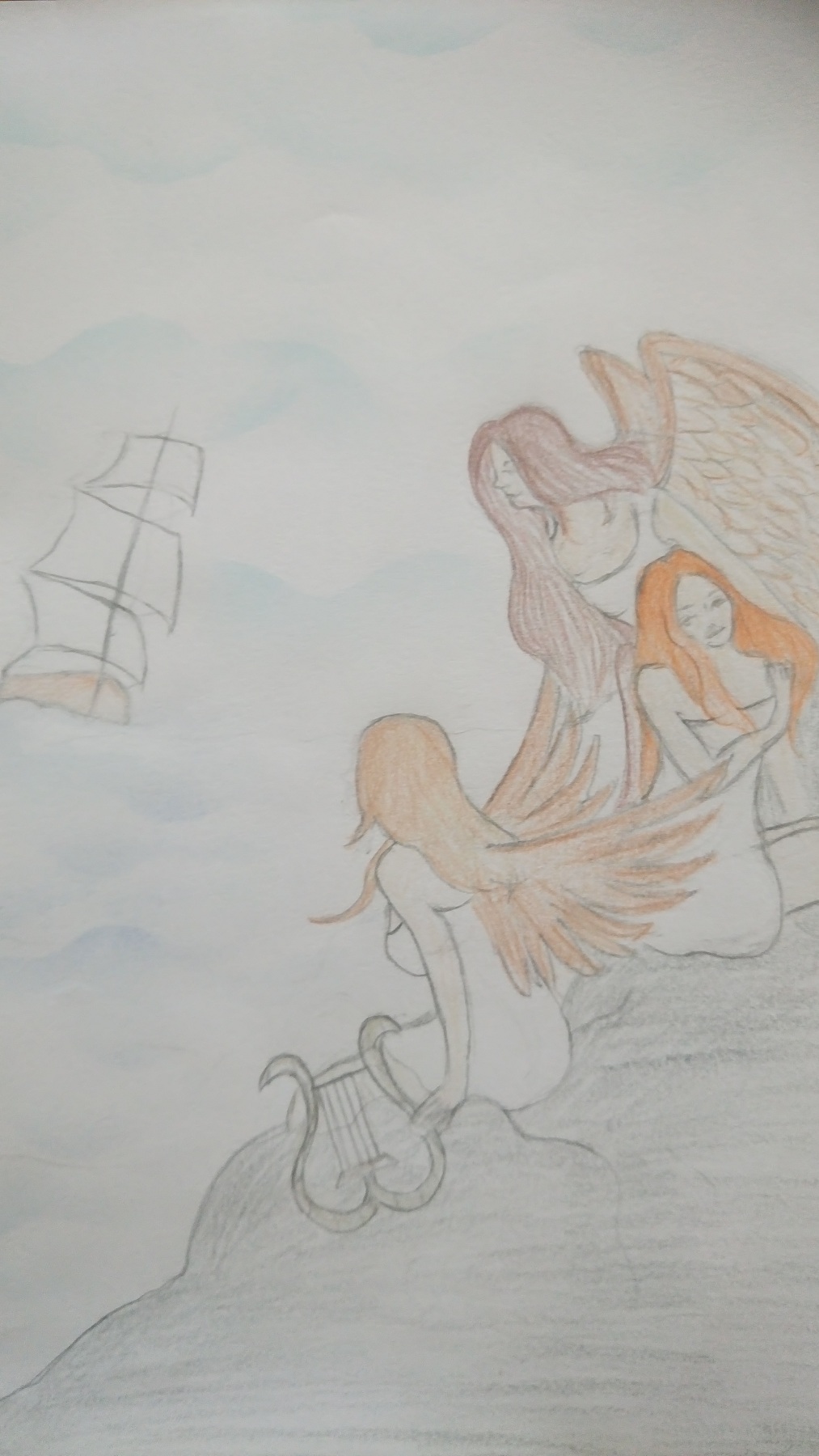1- The Siren Parthenope and the origin of Naples
“Omnigenum rex aitor SCS IAN Partenopem tege fauste”
Here you are the mysterious words which nowadays can be read on a gravestone situated in San Lorenzo Maggiore in the historical center of Naples.
The story of the origins of Naples links to that of the siren Parthenope, in a dimension suspended between myth and reality.
Therefore, let us start from the tale of the siren Parthenope.
According to the Greek mythology, Parthenope and her sisters Ligia and Leucosia tried, in vain, to bewitch Odysseus with their singing.
Half-women, half-birdlike, these creatures were the daughters of Melpomene, the Muse of Tragedy, and the River God Achelous. It is said that with their haunting music they lured to death every sailors passing by.
 When the ship of the Homeric hero met the sheet of water placed halfway between Positano and the bay of Ieranto, she tried to bewitch the valiant Odysseus: in fact, at the crack of dawn, the siren Parthenope had been lying on the rock, as usual, when she saw at the horizon the shape of a boat. It was the black ship of Odysseus and his companions.
When the ship of the Homeric hero met the sheet of water placed halfway between Positano and the bay of Ieranto, she tried to bewitch the valiant Odysseus: in fact, at the crack of dawn, the siren Parthenope had been lying on the rock, as usual, when she saw at the horizon the shape of a boat. It was the black ship of Odysseus and his companions.
Her eyes lit up mischievously and a hint of a somewhat disquieting smile settled on her lips.
She called her sisters in order to play the usual macabre game that satisfied them so much.
They lurked on the usual rock full of human bones that the wind and the sea had made ghostly white, waiting….
But when the ship drew near the Sirens' island, Odysseus bade all his shipmates stop up their ears with moulded wax, so that they could not hear. He alone kept his hearing; but he had himself lashed to the mast so that he could not move, and he forbade them to loose him, however he might plead, under spell.
As they sailed near, his soul gave way. He heard a wild sweetness coaxing the air, as a minstrel coaxes the harp; and there, close by, were the sirens sitting in a blooming meadow that hid the bones of men. Beautiful, winning maidens they looked; and they sang, entreating Odysseus by name to listen and abide and rest. Their voices were golden-sweet above the sound of wind and wave, like drops of amber floating on the tide; Odysseus begged his men to let him go free. But they, deaf alike to the song and the sorcery, rowed harder than ever. At length, song and island faded in the distance.
Parthenope, desperate for this refusal, chose to throw herself in the sea, dying.
Carried by the currents, her body finished melancholically on the lash rocks of the island of Megaride. And here it was found, with her eyes closed in the white face and the long hair that swayed in the water. The heart-breaking siren was composed in a magnificent sepulcher.
In short time, the extraordinary creature became the guardian of that place full of history, honored with sacrifices and torchlight processions and venerated by the people, who chose to give her name to the village of fishermen that rose along the coast.
According to a little less legendary version, Parthenope really existed. She would have been the beautiful daughter of a Greek captain left towards the coast of Campania in order to establish a colony there. Then, she died in the sea, during a shipwreck.
Today, as for “enchantment”, the city of Naples is still attached to the siren and the Neapolitans are proud to call themselves “Partenopei”.

La sirena Partenope e le origini della città di Napoli
“Omnigenum rex aitor SCS IAN Partenopem tege fauste”
Quste sono le parole misteriose che si possono leggere oggi su una lapidenella chiesa di S. Lorenzo Maggiore nel centro storico di Napoli.
La nascita della città di Napoli coincide con quella della sirena Partenope in una dimensione sospesa tra mito e realtà.
Ecco dunque il racconto della sirena Partenope.
Secondo la mitologia greca, Partenope insieme alle sue sorelle Ligia e Leucosia, cercò, invano,di stregare Ulisse.
Queste creature, metà donne e metà uccelli erano figlie di Melpomene, Musa della Tragedia e di Achelous, Dio dei fiumi. Si narra che con il loro canto seducente ammaliavano i marinai conducendoli alla morte.
Quando la nave dell'eroe greco arrivò nello specchio di acque tra Positano e la baia di Ieranto, Partenope tentò di stragare il valoroso eroe: alle prime luci dell'alba, la sirena Partenope era adagiata, come di consueto, sopra uno scoglio quando intravide all'orizzonte la sagoma di una nave. Si trattava della nave di Odisseo e dei suoi compagni.
Il suo sguardo malvagio si illuminò e un sorriso sinistro le increspò le labbra.
Chiamò le sorelle per dare vita al solito macabro gioco che tanto le deliziava.
Si appostarono sullo scoglio composto di ossa umane che il vento e le onde avevano sbiancato e rese spettrali, e attesero......
Avvicinandosi all'Isola delle Sirene Odisseo intimò ai suoi uomini di tapparsi le orecchie con la cera perchè non potessero udire. Solo lui non lo fece ma si legò all'albero maestro e vietò ai suoi uomini di liberarlo anche se li avesse supplicati di farlo, sotto incantesimo.
Mentre la nave si avvicinava sempre più all'isola la forza di Odisseo venne meno. Udì una dolcissima melodia pervadere l'aria, struggente come quella proveniente dall'arpa di un menestrello. E lì erano le sirene, sedute su un prato fiorito che celava le ossa. Il loro aspetto era quello di bellissime fanciulle. Cantavano e chiamavano Odisseo pregandolo di ascoltare. La loro voce dolce si elevava al di sopra del rumore del vento e delle onde come gocce di ambra fluttuanti sulle acque dell'oceano. Odisseo supplicò i suoi uomini di liberarlo. Ma quelli, sordi alla musica e al sortilegio, remavano con più vigore. Infine, ormai lontani, l'eco del canto e la stessa isola, svanirono.
Partenope, disperata a causa del rifiuto, preferì annegare tra le onde.
Trasportato dalla corrente il suo corpo finì sugli scogli lambiti dalle onde dell'isola di Megaride.
E qui venne ritrovato. Il volto pallido, gli occhi chiusi e i lunghi capelli fluttuanti tra le onde. La sirena dal cuore spezzato venne riposta in un magnifico sepolcro.
In breve la straordinaria creatura divenne la custode di quel luogo colmo di storia, onorata con sacrifici e venerata con processioni notturne al chiarore di torce da quella gente che volle dare il suo nome al villaggio di pescatori che sorgeva lungo la costa.
Secondo una versione meno fantastica, Partenope è realmente esistita. Sarebbe stata la bellissima figlia di un capitano greco che aveva fondato in Campania una colonia. Partenope sarebbe morta durante un naufragio in quelle acque.
Oggi la città di Napoli sembra ancora subire il fascino della sirena e i Napoletani sono orgogliosi di definirsi "Partenopei".
1) Deniz Kızı Parthenope ve Nepal'in Kökleri ( Turkish Version )
Bugünlerde Nepal’in merkezinde, San Lorenzo Maggiore’de yer alan bir mezarlığın üzerinde okuyabileceğiniz gizemli bir yazıyı bulacaksınız. Nepal ‘in köklerinin hikayesi efsaneyle gerçeğin arasında bulunan Parthenope ismindeki bir denizkızına bağlanır. Bu yüzden haydi deniz kızının hikayesiyle başlayalım…
Yunan mitolojisine göre Pathenope ve kız kardeşleri Ligia ve Leucosia , Odysseus ‘u şarkı söyleyerek büyülemeye çalışırlar. Yarı kadın yarı kuş olan bu yaratıklar Şiir Tanrıçası Melpomene ve Nehir Tanrısı Achelous’un kızlarıdır. Söyledikleri akıllardan çıkmayan çıkmayan müzikler oradan geçen denizcileri ölüme davet eder. Kahraman Humeriz gemisi Postino ile Ieranto körfezinin arasına geldiğinde de yiğit Odysseus ‘u büyülemeye çalışır. Tam şafak vaktinde ufukta geminin silüetini gördüğünde deniz kızı Parthenope her zamanki gibi kayaların üzerinde uzanır. Bu siyah gemi Odysseus ve arkadaşlarının gemisidir. Dudaklarına rahatsız edici bir gülümseme yerleştirir ve her zamanki keyifli oyunlarını oynamak üzere kız kardeşlerini çağırır. Rüzgar ve denizin ölümcül bir beyazlık kattığı , ölü bedenlerin kemikleriyle bezeli kayalıklara pusu kurarlar ve beklemeye başlarlar. Ancak gemi denizkızlarının adasına yaklaştığında Odysseus arkadaşlarının kulaklarını balmumu ile tıkamalarını iter. Böylece onlar hiçbir şey duyamayacaklardır. Sadece o duyacaktır fakat kendisini de geminin direğine sıkıca bağlatır ve arkadaşlarına onu serbest bırakmalarını yasaklar. Ancak büyü etkisini gösterdiğinde onlara yalvarmaya başlar. Gemi o yakınlaştıkça ruhu boyun eğmeye başlar. Havada gezinen tatlı bir ses duyar , arp sesini andıran. Deniz kızları kemikten kayalıkların üzerinde çiçekli bir yeşilliğin ortasında oturmaktadır. Güzeller güzeli deniz kızı onlara bakar ve şarkısını söyler.Yakarışı devam eden Odysseus dinler, bekler ve rahatlamaya başlar. Ses rüzgar ve dalga seslerinin üzerinden gelen altın vari tatlılıkta , gelgit dalgalarının üzerinde yüzen kehribar taneleri gibi bir sestir. Oysseus adamlarına onu serbest bırakmaları için yalvarır. Ama adamları sese ve onları büyüleyecek herşeye karşı sağırdırlar. Nihayet ada ve şarkı uzakta belli belirsiz kalır. Bu reddediliş karşısında hayal kırıklığına uğrayan Pathenope kendini denize atmaya ve ölmeye karar verir. Akıntı onun ölü bedenini Megaride adasının kayalıklarına taşır. Ve orada bembeyaz yüzü , gözleri kapalı ve uzun saçları suyun üzerinde salınırken bulunur. Kalbi kırık deniz kızı mükemmel bir mezarın içine yerleştirilir. Kısa süre sonra bu olağan üstü yaratık bu tarih kokan yerin koruyucusu olur, adaklarla ,fener alaylarıyla onurlandırılır ve oradaki balıkçıların kurmuş olduğu köye ismi verilir. Bir rivayete göre Parthenope gerçekten yaşamıştır. Onun Campania kıyılarının karşı yakasında bir koloni kurmak için yerleşen Yunan bir kaptanın kızı olduğuna ve bir deniz kazasında öldüğü varsayılır.
Bugün Nepal hala bu deniz kızı ile ilişkilendirilir ve Nepalliler kendileri ‘Parhenopei’ demekten gurur duyarlar.
Sirēna Partenelope un Neapoles izcelsme( Latvian version)
“Omnigenum rex aitor SCS IAN Partenopem tege fauste”
Tie ir mistikas apvīti vārdi, kas mūsdienās ir izlasāmi uz kapakmens San Lorenco Magiores vēsturiskajā centrā Neapolē.
Stāsts par pilsētas Neapoles izcelsmi ir saistīts ar sirēnu Partenelopi, kura dzīvo dimensijā, kas atrodas starp mītiem un realitāti.
Sāksim stāstu par sirēnu Partenelopi.
Saskaņā ar seno grieķu mitoloģiju, Partenelope un viņas māsas sirēnas Ligija un Leokosija mēģināja savaldzināt Odiseju ar savām maģiskajām balsīm.
Sirēnas ir puscilvēki, pusputni. Viņas bija meitas traģēdijas mūzai Melpomenei un upes dievam Ahelojam. Ir nostāsti, ka ar savām stindzinošajām dziesmām tās savaldzina un nogalina ikvienu, kas kuģo tām garām.
Kad Homēra varonis Odisejs bija sasniedzis plaisu starp Pozitano un Leranto līci, Partenelope centās sasaukt dievišķo Odiseju. Viņa, kā parasti, ausmā bija zvilnējusi uz akmeņiem, kad tuvojamies pamanīja laivas apveidus. Tas bija Odiseja un viņa pavadoņu Melnais kuģis.
Partenelopes acis iemirdzējās degsmē un lūpās parādījās viltīgs smīns.
Viņa sasauca savas māsas, lai paspēlētu ierasto nāves spēli, kas viņām sagādāja baudu.
Viņas gaidīja uz sava akmens, kas bija pārklāts ar cilvēku kauliem, kurus vējš bija nospodrinājis spocīgi baltus.
Bet, kad kuģis brauca garām sirēnu salai, Odisejs bija pavēlējis saviem vīriem aizbāzt ausis ar vasku, lai tie neko nedzirdētu. Viņš vienīgais neielika vasku, bet bija piesējis sevi pie kuģa masta, lai nevarētu pakustēties. Viņš bija aizliedzis pavadoņiem viņu atsiet, lai kā viņš lūgtos burvestību varā.
Jo tuvāk viņi brauca, jo vairāk viņa dvēsele vēlējās pamest viņa ķermeni. Viņš dzirdēja maigas, saldas, tomēr biedējošas skaņas, ko radīja arfas un sirēnu balsis. Un tur, tuvumā, bija sirēnas, kas sēdēja ziedošā pļavā, kas apslēpa cilvēku kaulus. Viņas izskatījās tik skaistas, kad tās dziedāja, lūdzot Odiseju sev blakus. To balsis bija cukursaldas, kas brīnišķīgi saplūda ar vēja un okeāna viļņu nestajām čalām. Odisejs izmisīgi lūdzās saviem vīriem, lai viņu atbrīvo. Viņš tik ļoti vēlējās nokļūt miera ostā pie sirēnu nestā daiļuma. Bet viņa palīgi, kas neko nedzirdēja no sirēnu dziesmu burvības, cīnījās spēcīgāk nekā jebkad agrāk. Pēc kāda laika sala un māsu radītās mānīgās skaņas izgaisa tālumā.
Partenelope, kas nespēja izturēt šo atraidījumu, izvēlējās mest sevi jūrā, nāves apskāvienā. Lēcienā, tās ķermenis piezemējās uz asiem akmeņiem pie sirēnu salas. Tur tas arī tika atrasts, ar aizvērtām acīm, līķa baltu seju un gariem, ūdenī virmojošiem matiem. Sirēna ar salauzto sirdi tika apglabāta okeāna dzelmē.
Pēc neilga laika šis neparastais atgadījums kļuva par pieminekli vēsturiskai vietai, kas bija celta uz milzīgiem upuru kalniem. Šī vieta tika godināta, to nosaucot kādā zvejnieku ciemata vārdā, kas vijās gar okeāna krastu, un to sauc par Neapoli.
Pēc kādas citas leģendas, Partenelope patiešām eksistējusi. Viņa bijusi kāda grieķu kapteiņa meita, kas izlēmusi doties dzīvot jūrā, kurā diemžēl arī palikusi.
Mūsdienās Neapoles iedzīvotāji joprojām atceras šo leģendu un lepni sauc sevi par partenelopiešiem.
2- The legend of the "Munaciello"
In the Middle Ages every building in Naples took water from the cisterns below, through wells, within which workers called "pozzari" where able to go being small and thin. They easily moved through these little channels, named "cunicoli", and climbed up the wells thanks to holes in the walls. These men actually had access to every house in the city through the wells.
In the half-light their cloak seemed like a monk’s habit. When they did not receive the agreed remuneration, they took revenge by breaking into the houses and stealing some valuable objects.
This is where some popular legends arose from, like the one known as the "Munaciello legend".
The Munaciello (in Neapolitan this means "little monk") was a man more interested in pretty young women than in waterworks and used the underground streets to appear and disappear under a mantle that resembled a monk's dress.
This bizarre spirit, most feared and most often named by the Neapolitans, always behaved in an unpredictable way: he showed his presence by leaving coins, hiding money inside houses to express sympathy and playing harmless tricks to be converted into numbers to play the lottery or, on the contrary, hiding objects, breaking dishes and other tableware or blowing in the ears of the sleepers to express antipathy. His appreciation was expressed by touching beautiful women and leaving them rewards between the stones of the walls. Therefore his disrespectful behaviour was often accompanied by benevolent "bequests" of money; but nobody was to be told what had happened, otherwise he would set himself against the beneficiary.
Naples is a “magic city” and Neapolitans take magic seriously. The legend of the munaciello is very dear to them. Nowadays several are said to have made fortunes through him, and hence when anyone has had a sudden increase of fortune they say: “Forse avrà il munaciello a casa sua” (perhaps he has had little Monk in his house).
3- Siffridina, Countess of Caserta
Today, the only remaining parts of Casertavecchia Castle are the walls and the stunning main tower, and maybe a ghost which belongs to Countess Siffridina Gentile. Siffridina married Tommaso d’Aquino, from whom Richard was born, who would later become Count of Caserta, after his father’s death and under Siffridina’s tutorship.
Richard married Violante, the daughter of the Emperor Frederik II of Swabia, but in 1267 he died leaving the county to his son Corradello, under the protection of Siffridina. The Countess supported the losing Swabian dynasty against Charles I of Anjou. She persuaded her nephew to rebel against the French and to become allied with Corradino of Swabia.
The courageous Siffridina, was imprisoned and held captive in the Swabian castle of Trani from 1268 until her death in 1279, because she had favoured the unfortunate descent of Corradino of Swabia and kept the names of the conspirators secret until the end. During her captivity she had been kept, for her express wish, on bread and water.
The countess Siffridina was very fond of Casertavecchia. This bond never broke, even after death, in fact it is said that during the long winter nights the ghost of the Countess wanders among the Cathedral and the ruins of the castle and its appearance is followed by long wails and incomprehensible words.